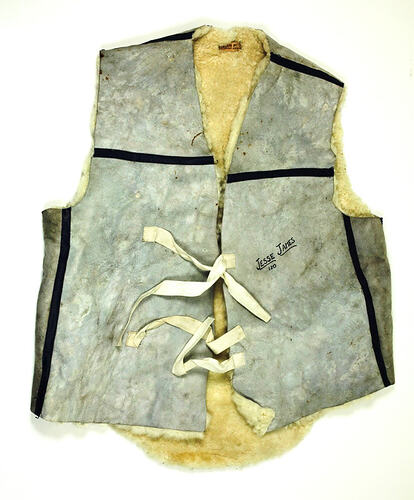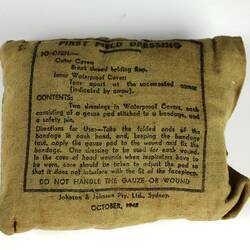Norman Henry James, known to his family as Harry, was born in Geelong in 1920, and was an unmarried bricklayer when he signed up to the Royal Australian Air Force Reserve on 9 January 1942. He then enlisted in the Australian Army in Frankston on 17 April 1942 - service number V215892. He served for four months in the Army Service Corps (ASC), 3 Australian Division, before transferring to the Royal Australian Air Force in Melbourne on 8 September 1942 - service number 419592. From 8 September to 7 November he was based at the ITS (Initial Training School) as an AC2 (Air Crew), part of the Empire Air Training Scheme (EATS). Harry hoped to be a pilot, but was assigned as 'Air Crew V' on 2 November, and on 7 November was transferred to No. 2 ED (Embarkation Depot) at Bradfield Park, in preparation for overseas service, where kitting and medical examinations were undertaken. He was briefly stationed at Ascot Vale before being sent to Canada on 15 January 1943 and attached to the Royal Canadian Air Force (RCAF). The EATS provided Britain with a pool of trained aircrew from Commonwealth nations who could then serve with the RAF, providing much-needed personnel for Britain. Over 37,000 Australian airmen were trained as part of Empire Air Training Scheme.
Harry transferred to No. 3 Manning Depot, Edmonton, Canada, before being posted to the Wireless School in Calgary in February. (His record later describes his specialization as Wireless Air Gunner or a WOAG - Wireless Operator Air Gunner.) He boarded there with Mr and Mrs Pike; his service record refers to Mr Pike in Spokane, Washington, as being a person to contact in an emergency.
In September he was transferred to the No. 2 Bombing and Gunnery School (BAGS) at Mossbank, Saskatchewan, a Commonwealth air training facility. In November 1943 he was discharged from the RCAF after being granted a commission as a sergeant and becoming a Pilot Officer. By early 1944 he was a Flying Officer at Nassau, in the Bahamas, then was sent up through the United States, back to Canada then from Halifax across to the United Kingdom in May 1944, an 11-day journey.
Within weeks he was assigned to the RAF 120 Squadron and receiving training in the operation of the Leigh Light, an anti-submarine searchlight fitted to some of the RAF Coastal Command patrol bombers to detect surfaced German U-boats at night. The 120 Squadron was equipped with Consolidated Liberators and used them to considerable effect, sinking 14 U-Boats outright, with shares in three more and eight damaged by the end of the war. (The unit, designation "8U", was disbanded in June 1945 at RAF Ballykelly in Northern Ireland.) After a month Harry was placed in the 1674 Heavy Conversion Unit, 17 Group RAF Coastal Command, then based at Aldergrove, an RAF station near Belfast, Northern Ireland. Heavy Conversion Units trained medium bomber flight crews to operate heavy bombers - Norman had previously flown on Canadian Bolingbroke, Norseman, Fleet Fort and Mitchell aircraft, and now was flying on Liberators.
Harry had a number of near misses during the war. He described changing squadrons because he didn't like the squadron leader - and the next day the entire squadron was killed. He sense of his own good fortune was to find meaning in his later life.
On 20 June 1945 Harry transferred from Ireland back to England, to Beccles airfield, carrying his suitcase of personal possessions. In in early October he was moved to 11 PDRC Padgate (near Warrington) prior to his departure for Australia. He disembarked in Sydney on 4 November 1945, and was discharged on 10 January 1946 at the rank of Flight Lieutenant.
After the war Harry re-trained as a town planner and worked in Moorabbin when the area was being sub-divided. He married his childhood friend Mary Beatrice - "Betty" (the donor) in August 1946. She had previously been engaged to a man killed in a flying accident. They named their daughter Finola - the name of Harry's Irish girlfriend.
Around 1950 Harry went to work at the Gordon Institute to teach building construction, and remained there until his retirement. He believed his good fortune again saved him when he was on the Westgate Bridge with students the day before it collapsed, on 15 October 1970. In another incident he lost three friends in a car crash on the way to their regular masonic lodge meeting - he was supposed to have been with them but had influenza.
Although Harry preserved his suitcase as a memento of his time in the Air Force, he did not like to talk about the war with his family. Occasionally he would wear his medals at Masonic functions, together with a tie and tails - he was its highest ranking member outside Melbourne at one time. His daughter remembers he kept his Air Force uniform in a cupboard and concealed the case by strapping it to the underside of the floor of a bedroom, beneath their weatherboard home in Geelong, which they had purchased in 1950. He told his family it contained live ammunition - indeed bullets were found in the case when it was donated to Museum Victoria, which were passed over to Victoria Police. After Harry died in January 2009 his family went looking for the case and found it a week before the home went to auction.
References
National Archives service record NORMAN NORMAN HENRY, barcode 5247106.
'Empire Air Training Scheme', Australian War Memorial, http://www.awm.gov.au/encyclopedia/raaf/eats/, accessed 20/11/2013
'Leigh light', Wikipedia, http://en.wikipedia.org/wiki/Leigh_light, accessed 20/11/2013
'No. 120 Squadron RAF', Wikipedia, http://en.wikipedia.org/wiki/No._120_Squadron_RAF, accessed 20/11/2013
More Information
-
Keywords
-
Authors
-
Article types


